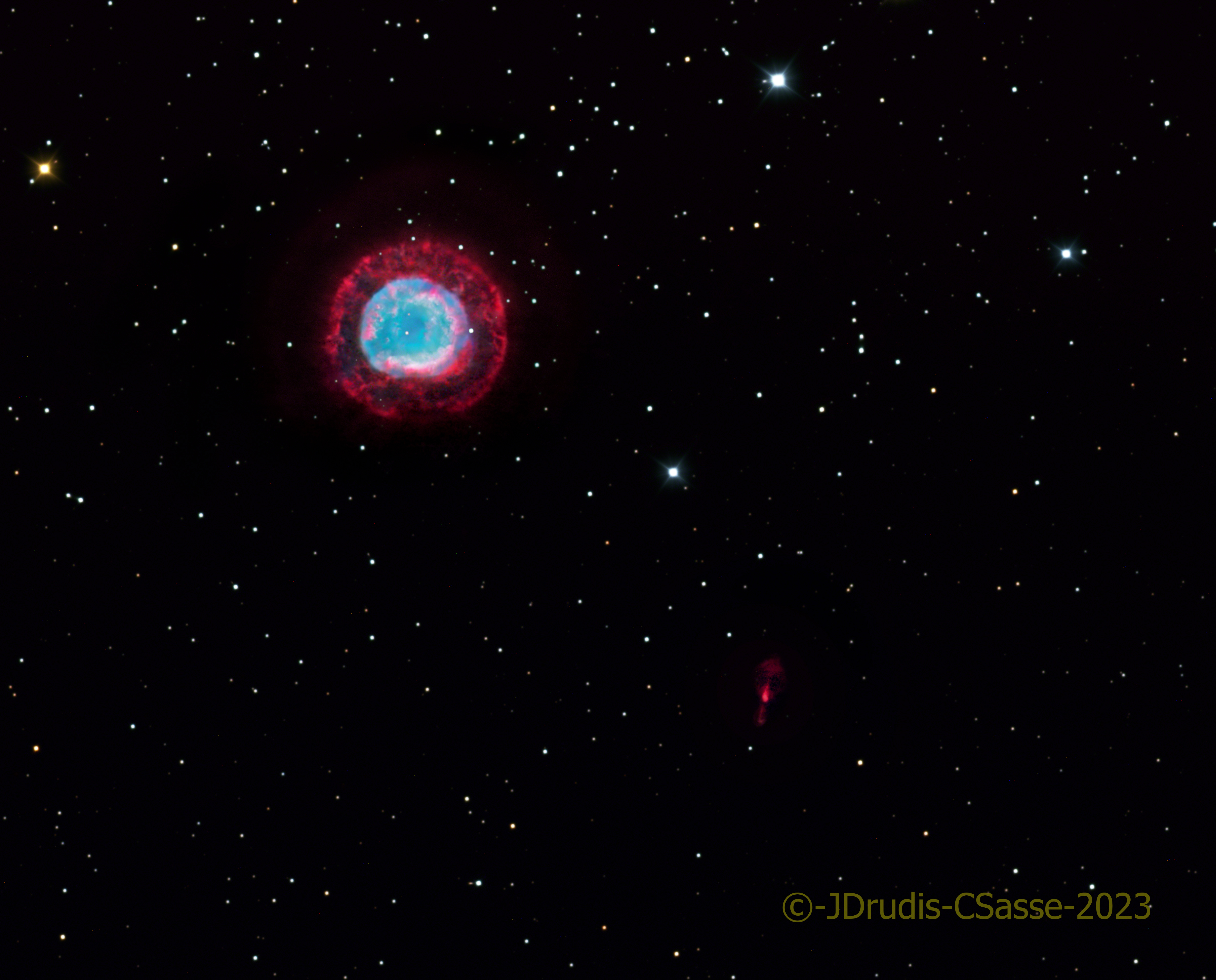Click on the image for a full resolution version
See this image also on Instagram
NGC 2438 is a small but still bright planetary nebula located about 2,900 light years away, in the Southern constellation Puppis. This nebula is found “inside” M46 (most of the stars in this frame belong to it), an open cluster, which is as far away as 5,400 light years. For many years, NGC 2438 was considered to be part of M46. After being discovered by William Herschel in 1786, this belonging was not discussed. It was first in 1963 that O’Dell suggested that NGC 2438 did not belong to the cluster and, in 2008, it was confirmed by measuring with enough precision, that the difference in distance of both the cluster and nebula was large enough and this discarded that NGC 2438 belongs to M46. Moreover, also the velocities of the nebula and the cluster’s stars were measured, giving a difference of about 30 km/s, confirming that the nebula does not belong to M46. The central white dwarf has a magnitude of 17.7 and a surface temperature of about 75,000 K.
This nebula has, as many other planetaries do, a structure with three “rings”. The brightest one is the one just around the central white dwarf. The second one is the neat red halo around the first ring and the third one is the very faint external halo. As planetary nebulae go, an important parameter, giving information about its current state as well as its immediate next evolutionary steps, is its ionization state. In planetary nebulae, the gas clouds around them are visible because they are ionized by the strong UV radiation coming from their central stars and emit visible radiation according to the composition of the cloud. The ionized atoms are in equilibrium with their neutral atoms. Recombination (meaning that ionized atoms capture back electrons to yield neutral atoms) is not the prevailing process in the beginning. As the expansion proceeds and the gas thins on, the amount of radiation received decreases and the atoms recapture electrons. The neutral atoms do not emit visible light and the nebula fades slowly away from our sight. NGC 2438, according to measurements made in 2014 by S. Öttl et al., has still a very high degree of ionization, meaning that the prevailing process is not recombination but the opposite.
Anyhow, this image shows yet another object (to the lower right of NGC 2438) that indeed belongs to M46. This is OH 231.84 +4.22, a protoplanetary nebula (a planetary nebula in its first stages of formation that will yield a full fledged planetary in some hundreds of years). This nebula is also called the Calabash Nebula (due to its shape) or the Rotten Egg Nebula (due to its composition, having a high concentration of Sulfur). Actually, this was the original intended target of this image, but taking deep frames with an SII filter did not yield much signal (the Halpha signal is way stronger). This means that, despite having a high concentration of sulfur, the intense radiation does not ionize it to SII, but to higher levels of ionization that are not captured with our filter.
Additional Information
Object
Name(s): NGC 2438
Type: Planetary Nebula
RA: 07h 41m 50s
Dec: -14º 44’ 07”
Constellation: Puppis
Size (arcmin): 1.1 arcmin
Magnitude: +10.8
Distance: 2,900 ly
Image
Date: 2022-12-15 to 2022-12-22
Location: Obstech, Río Hurtado, Chile
Size (arcmin): 15.4×12.5 arcmin
Telescope: 24” f/6.5 Reflector
Camera: QHY 461 (11760x8896pix)
Guiding: off-axis guider
Total exposure: 41 hours (Ha: 16h; OIII: 10h; SII: 12h; RGB: 3h)
Processing: CCDStack and Photoshop CC 2023

